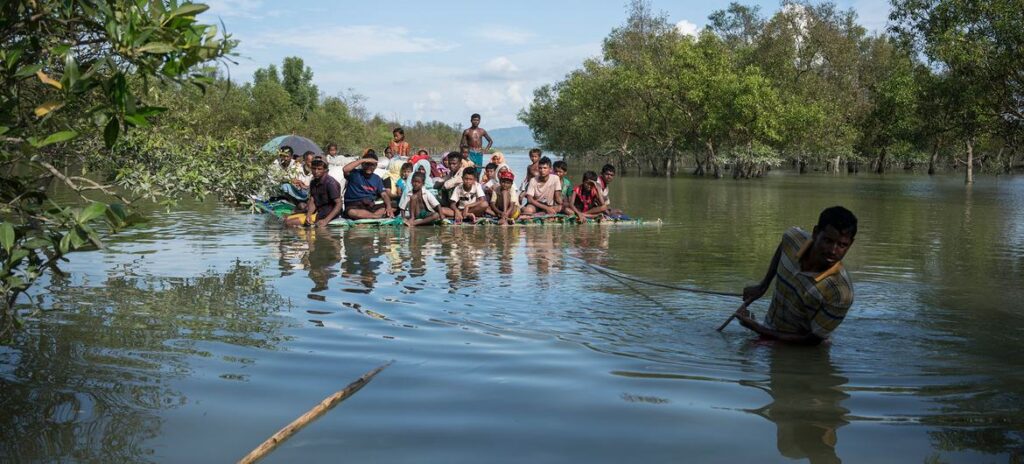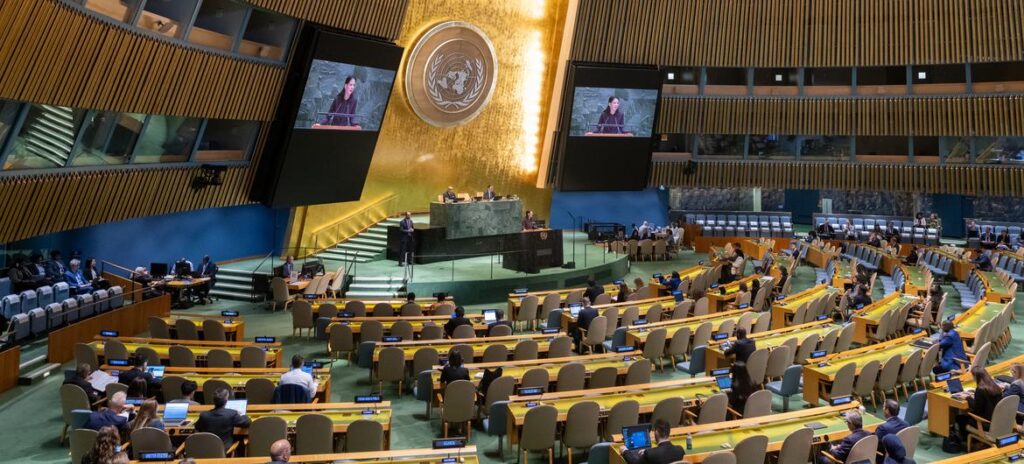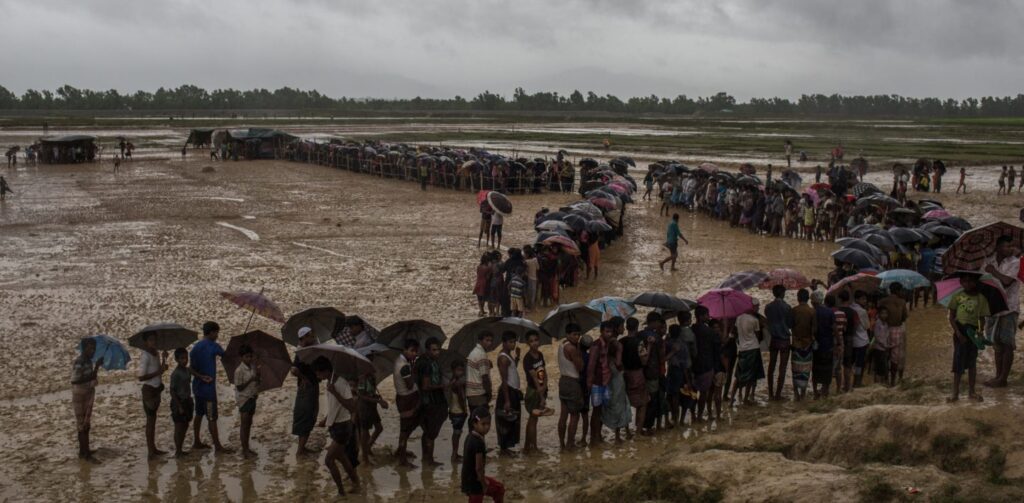Rohingya Plight in Myanmar, a ‘Test for Humanity’
ASIA-UPDATES ON MYANMAR ROHINGYA GENOCIDE, 6 Oct 2025
Vibhu Mishra | UN News - TRANSCEND Media Service

Rohingya refugees cross the Naf River on a makeshift raft while fleeing violence in Myanmar, on their way to Bangladesh. © UNICEF/Mackenzie Knowles-Coursin
30 Sep 2025 – “Houses burned. Neighbours killed. Hope vanishing.” With those stark words, General Assembly President Annalena Baerbock opened a high-level UN conference today, as alarm rises over the impact of Myanmar’s deepening crisis which threatens to destabilise the wider region.
At the heart of the emergency are the Rohingya Muslims, denied Burmese citizenship, driven from their homes and forced into camps or exile.
More than a million now live as refugees in Bangladesh, while countless more remain displaced or trapped – alongside other minorities – inside Myanmar under conditions UN leaders described as “dire” and “unsustainable.”
The conference at UN Headquarters in New York, brought together top UN officials, heads of state and governments, to galvanise action alongside Rohingya activists.
Briefings and reports laid bare the daily realities since the February 2021 military coup: forced recruitment, sexual violence, airstrikes, starvation and mass displacement.
Humanitarian agencies warn that resources are running out, leaving refugees malnourished and pushing more people into taking dangerous sea journeys.
Conditions inside Myanmar’s Rakhine state – ancestral home of the Rohingya – are described as the worst in decades, with civilians caught between junta forces and ethnic armed groups.

General Assemby President Annalena Baerbock (at podium and on screens) addresses the high-level conference of the UNGA on the situation of Rohingya Muslims and other minorities in Myanmar.
UN Photo/Manuel Elías
‘Human rights trampled’
The Secretary-General, in a statement read by his Chef de Cabinet Courtenay Rattray, said the crisis has “trampled on the human rights, dignity and safety of millions and threatens regional stability.”
He urged three immediate steps: protecting civilians in line with international law, guaranteeing humanitarian access, and reinvigorating investment to ease the strain on refugees and host communities.
“The solution to this crisis lies ultimately in Myanmar,” the message stressed, calling for an end to persecution and recognition that “the Rohingya belong – as full citizens.”
A crisis ‘that should put us to shame’
Assembly President Baerbock underscored the scale of suffering.
“Over five million Rohingya men, women and children share some version of this story,” she said, noting that 800,000 children remain out of school in Bangladesh’s Cox’s Bazar camp alone.
Humanitarian funding is critically short, with the 2025 response plan just 12 per cent funded.
“This should put us to shame,” she declared, urging states to boost aid and pursue a political solution that would enable safe, voluntary and sustainable return.
Demand for accountability
For Rohingya activists, the conference was not another moment of awareness but a demand for justice.
Wai Wai Nu, founder of the Myanmar Women’s Peace Network, told delegates that the atrocities did not end in 2017, when over 750,000 Rohingya men, women and children fled violence described as a “textbook example of ethnic cleansing” by then UN High Commissioner for Human Rights, Zeid Ra’ad Al Hussein.
“It has worsened,” she said, pointing to killings, forced conscription, sexual violence and starvation inflicted by both the Myanmar military and ethnic armed groups fighting the junta.
“Without action, the Rohingya exodus will continue until there is no more Rohingya left in Myanmar,” she warned, urging cross-border humanitarian corridors, targeted sanctions and prosecutions for atrocity crimes.
‘A test for humanity’
Rofik Husson, founder of the Arakan Youth Peace Network, offered his own testimony of displacement and violence, recalling how the junta forced Rohingya men and boys into service, often as human shields. In one week alone, he said, at least 400 were killed.
He described village burnings and drone strikes, including a May 2024 massacre that displaced 200,000 people in a single day.
“Ending the crisis of insecurity for the Rohingya community is a test for this Assembly and a test for humanity itself,” he told delegates, calling for an internationally supervised safe zone in northern Rakhine.
No agreed pathway to peace
Adding a wider lens, Special Envoy Julie Bishop stressed that Myanmar’s multifaceted crisis is inseparable from the political turmoil unleashed by the 2021 coup.
With no ceasefire in place and armed conflict spreading, she warned that planned elections later this year would fuel further violence rather than deliver legitimacy.
“There is no agreed pathway to peace,” she said, cautioning that international condemnation of the junta has ebbed even as abuses persist.
A fragile hope
Despite the grim accounts, speakers emphasised that solutions remain possible if political will can be summoned.
Ms. Baerbock closed her remarks by noting: “The Rohingya people have survived eight years of hardship, displacement and uncertainty. Their resilience is extraordinary. Our response must match it.”
For Rohingya activists, the message was equally clear: declarations are no longer enough.
“Justice is not optional…It is the only deterrent, the only path to peace,” Ms. Nu said.
Tags: Bangladesh, Buddhists, Burma/Myanmar, East Asia, Genocide, Migrants, Muslims, Refugees, Religion, Rohingya, Statelessness, United Nations
DISCLAIMER: The statements, views and opinions expressed in pieces republished here are solely those of the authors and do not necessarily represent those of TMS. In accordance with title 17 U.S.C. section 107, this material is distributed without profit to those who have expressed a prior interest in receiving the included information for research and educational purposes. TMS has no affiliation whatsoever with the originator of this article nor is TMS endorsed or sponsored by the originator. “GO TO ORIGINAL” links are provided as a convenience to our readers and allow for verification of authenticity. However, as originating pages are often updated by their originating host sites, the versions posted may not match the versions our readers view when clicking the “GO TO ORIGINAL” links. This site contains copyrighted material the use of which has not always been specifically authorized by the copyright owner. We are making such material available in our efforts to advance understanding of environmental, political, human rights, economic, democracy, scientific, and social justice issues, etc. We believe this constitutes a ‘fair use’ of any such copyrighted material as provided for in section 107 of the US Copyright Law. In accordance with Title 17 U.S.C. Section 107, the material on this site is distributed without profit to those who have expressed a prior interest in receiving the included information for research and educational purposes. For more information go to: http://www.law.cornell.edu/uscode/17/107.shtml. If you wish to use copyrighted material from this site for purposes of your own that go beyond ‘fair use’, you must obtain permission from the copyright owner.
Join the discussion!
We welcome debate and dissent, but personal — ad hominem — attacks (on authors, other users or any individual), abuse and defamatory language will not be tolerated. Nor will we tolerate attempts to deliberately disrupt discussions. We aim to maintain an inviting space to focus on intelligent interactions and debates.
Read more
Click here to go to the current weekly digest or pick another article:
ASIA-UPDATES ON MYANMAR ROHINGYA GENOCIDE:
